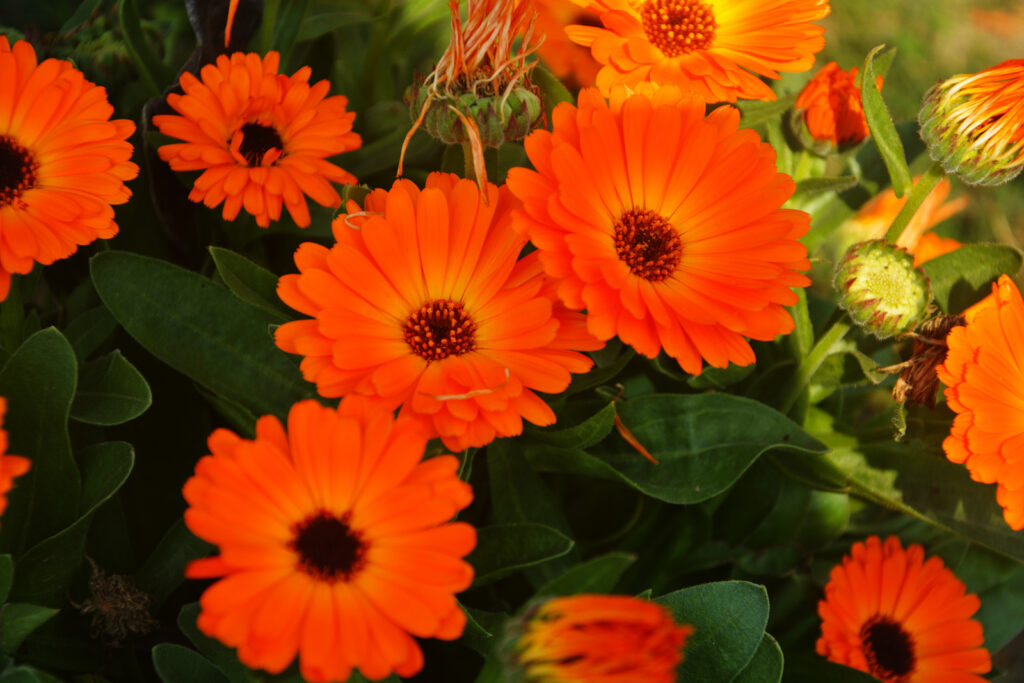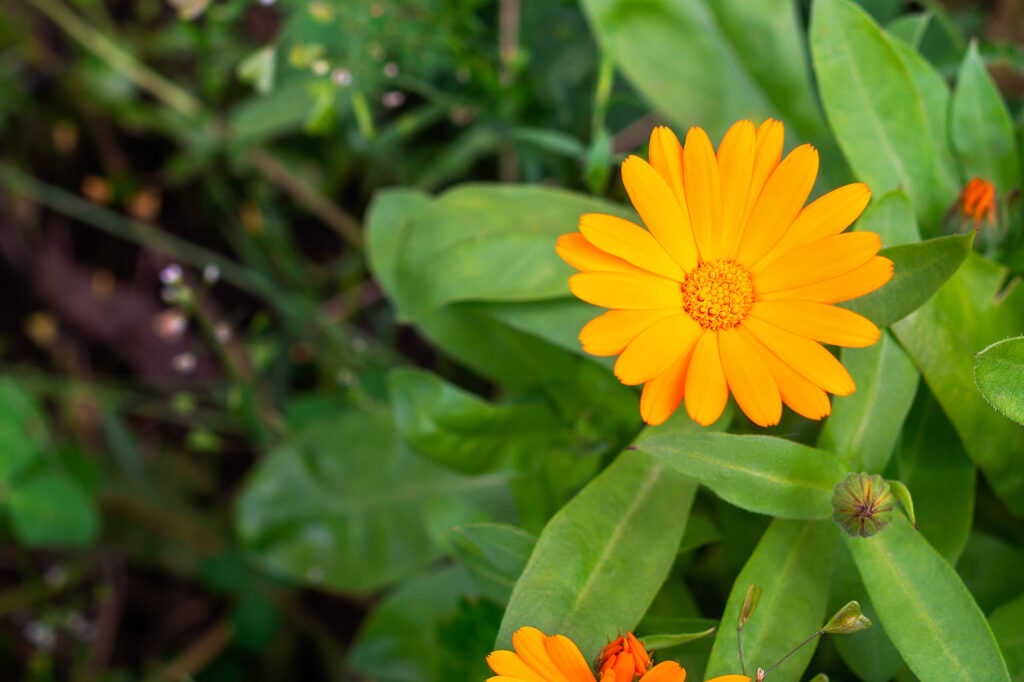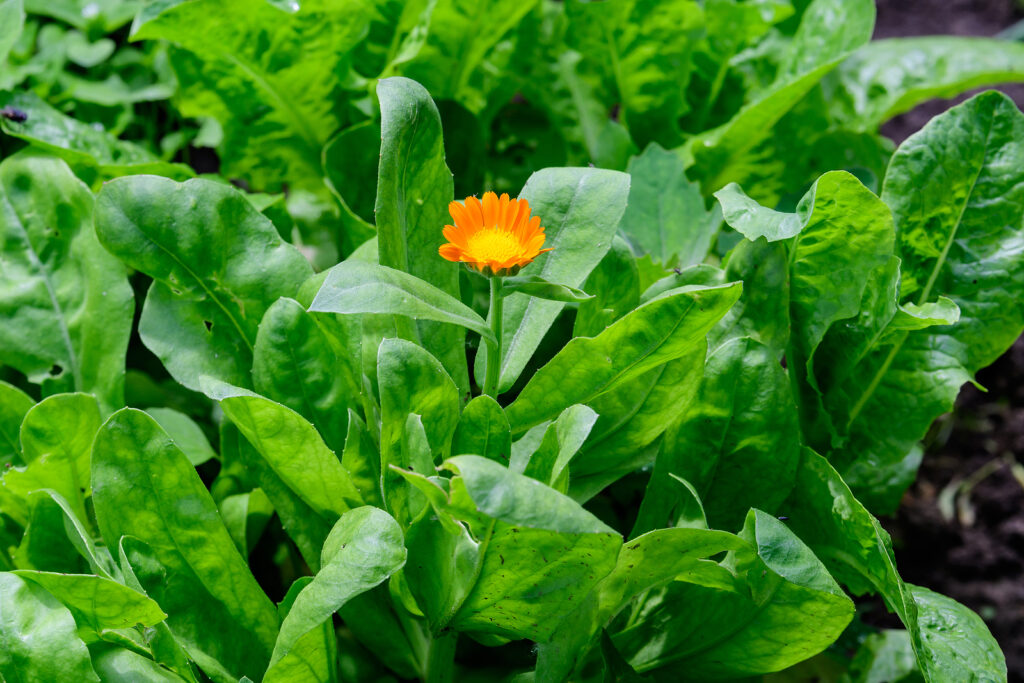Calendulas are the cool-season cousins of summer marigolds. These easy-to-grow annuals are nicknamed “pot marigolds” because they resemble marigolds and the leaves were once cooked in pots as a vegetable.
Calendulas can be readily grown from seed. The large seeds are easy to handle and plant and they germinate quickly. Use calendulas in beds and as edging in borders; grow them in the herb garden (the leaves and flowers are edible) and in containers.
The big rayed flowers of pot marigolds can be cream, yellow, apricot, gold, and persimmon. The stems are strong and the flowers are long-lasting making calendulas a good cutting flower. Most calendulas dislike heat but thrive in cold and even freezing weather.
Calendula is a genus of 20 to 30 species. Calendula is native to arable land from South Europe to North Africa.
Flower Garden Success Products at Amazon:
- Wildflower Seed Mix Attracts Hummingbirds and Butterflies
- Eden Brothers All Perennial Seed Mix
- 10 pcs Stainless Steel Garden Hand Tool Set
- Gorilla Cart 4 Cu. Ft, 300-pound Capacity

Get to know Calendula
- Plant type: Annual, sometimes grown as a biennial in mild-winter regions
- Growing Zones and range: 2-11
- Hardiness: Survives light to moderate freezes; does not like long periods of heat in the 90’sF.
- Height and width: 6 to 12 inches (15-30cm) tall and wide, some cultivars can grow to 3 feet (91cm) tall.
- Foliage: Bushy plants have long, slender leaves that are aromatic and slightly sticky.
- Flowers: Brilliant oranges and yellows, also apricots and cream; round, disc, and ray flowers can be single, double, and semi-double about 3 to 4 inches (7.6-10cm) across atop long stems; some have chocolate-brown centers.
- Flower colors: White, cream, orange, yellow, and apricot shades
- Bloom time: Spring through summer in cold-winter climates; fall, winter, and spring in mild-winter regions
- Uses: Grow calendula in beds, borders, and containers; as cut flowers; use as a pest-deterring edging plant in vegetable beds.
- Common name: Pot marigold
- Botanical name: Calendula officinalis
- Family: Asteraceae
- Origin: South Europe to North Africa
Where to plant Calendula
- Plant Calendula in full sun in most regions; where summers are very hot, plant in bright partial shade
- Grow Calendula in poor to rich, well-drained soil.
- Calendulas prefer a soil pH of 6.5 to 7.
Calendula uses
- Calendulas are ideal for containers or as massed bedding plants.
- Calendulas are long-lasting cut flowers.
- Flowers are edible with a slightly tangy taste.

When to plant Calendula
- Plant established seedlings in the garden in early spring not earlier than 2 to 3 weeks before the last frost. In Zones 8-11 plant pot marigolds in the fall for winter and spring bloom.
- Start seed indoors 6 to 8 weeks before the last spring frost for transplanting out. Seeds germinate in 10 days.
- Transplant seedlings to the garden when temperatures are 50° to 80°F (10°-26.7°C); colder or warmer temperatures will slow growth.
- Sow seed outdoors in early summer for color in late summer through autumn; in mild winter regions sow seed in August for blooms in December.
- Calendula is usually grown from seed; it can be propagated by stem cuttings.
- Sow seeds 1/2 to 1 inch deep as soon as the ground can be worked.
- Second sowing in early summer gives a good autumn bloom.
- In mild-winter climates, sow again in late summer or early fall for winter and spring color.

Planting and spacing Calendula
- Start seed indoors in flat, small pots, or six-packs filled with moistened potting soil. Sow seed 1/8 inch deep spaced 1 inch (2.5cm) apart or in individual pots.
- Germinate seed at 65° to 75°F (18-24°C); germination will occur in 8 to 10 days.
- Thin or transplant indoor or outdoor started seedlings when they are 4 to 6 inches (10-15cm) or taller.
- Harden off seedlings for a couple of days before transplanting them outdoors.
- Set calendula 10 to 12 inches (25-30cm) apart.
- Protect plants from temperatures below 28°F (-2.2°C).
Good Products for Seed Starting Success at Amazon:
- Jump Start Germination Station w/Heat Mat Tray, 72-Cell Pack, Dome
- Espoma Seed Starting Mix
- 200 Count- Jiffy 7 Peat Soil Seed Starting Plugs
- Seed Starter Kit with Humidity Dome (120 Cells Total Tray)
- AgrobriteT5 Fluorescent, 2-Foot, Grow Light System
How to water and feed Calendula
- Keep the soil evenly moist but not wet where growing pot marigolds.
- Mulch plants in dry areas with chopped leaves or aged compost; this will preserve soil moisture.
- Fertilize pot marigolds every 4 weeks with a 5-10-10 fertilizer or add a 9-month, slow-release fertilizer into the soil at planting time.
Calendula care
- Remove spent blooms to promote new blooms. Trim plants if they become straggly.
- Keeping Calendula flowers picked as soon as they fade will prolong their life, but it is an annual.
- Calendula will self-sow.
- Protect plants from hard freezes (26°F/-3.3°C) with frost blankets or cardboard boxes set over plants.

Growing Calendula as a houseplant
- Calendula can be grown in a cool room with average humidity.
- It should be potted in an all-purpose growing medium that is kept evenly moist, and placed in direct light.
- Fertilize monthly during its growing and flowering period
Calendula kitchen use
- Harvest flowers to use as herbs as soon as they are fully open. Petals may be used fresh or dry.
- Dry flowers on a screen in a warm, airy place. Store dried petals in an airtight container.
- Leaves are edible, but not always palatable.
Calendula pests and diseases
- Calendula attracts aphids, mealybugs, scale insects, thrips, and whiteflies.
- Protect Calendula from slugs and snails.
- Where nematodes are a problem, grow Calendulas in containers.
- Calendula is prone to botrytis blight, leaf spot, powdery mildew, and root and stems rot.
Calendula propagation
- Calendula is usually grown from seed; it can be propagated by stem cuttings.
- Sow seeds 1/2 to 1 inch deep as soon as the ground can be worked.
- Start seeds indoors 6 to 8 weeks before transplanting.
- Seeds germinate in 10 days.
- Second sowing in early summer gives a good autumn bloom.
- In mild-winter climates, sow again in late summer or early fall for winter and spring color.
Calendula varieties to grow
- Calendula officinalis, the old-fashioned pot marigold, can be grown in the herb garden. They grow 12 to 24 inches (30-61cm) tall. They have smaller, more delicate flowers than hybrid bedding types.
- Calendula hybrids are related to Calendula officinalis, flowered are showy and up to 3 inches (7.6cm) wide.
- ‘Apricot Sherbet’ is early blooming and heat resistant.
- ‘Bon Bon’ blooms in hot weather; colors are yellow, orange, and apricot.
- ‘Coronet’ grows to 12 inches tall.
- ‘Fiesta Gitana’ is also called ‘Gypsy Festival’; it grows to 12 inches tall.
- ‘Pacific Beauty’ are robust plants in mixed or individual colors.
- ‘Tough of Red Mixed’ has maroon-red flowers on stems to 18 inches.
Calendula frequently asked questions
Q: Why is calendula called pot marigold?
A: Calendulas are not marigolds. In the 1600s calendulas came to be known as “Mary’s Gold” which was contracted to “marigold”. Mary’s Gold is likely a reference to Mary Queen of Scots, the mother of Queen Elizabeth I. the queen of England at that time. Calendula leaves and flowers are edible with a slightly bitter taste. They have long been used as a flavoring in cooking and so came to be known as pot marigolds.
Q: What kind of care do calendulas need?
A: Calendula likes full sun but will grow in light shade. It wants soil rich in organic matter. Keep the soil evenly moist. Remove spent flowers regularly.
Q: Why do my calendulas suffer in hot weather?
A: Calendulas prefer cooler weather; they can withstand a light frost. Sow the seeds early so that the roots are well established before warm weather arrives. There are varieties that are heat resistant–try Bon Bon and Pacific Beauty cultivars.
Related Articles:
- 20 Perennials That Bloom for 6 to 8 Weeks
- Shrubs with Showy Flowers Season-by-Season
- Trees in Garden Design
- Growing Annuals for Summer Bloom
- Trees—click here for more articles
- Shrubs—click here for more articles
- Perennials—click here to see more
- Annuals—click here to see more















